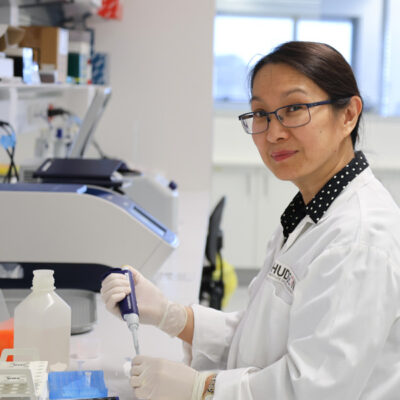Kat’s story | endometriosis
By Hudson Institute communications
For years, Kat was told by doctors she might never have children due to severe endometriosis. Now, the mother of twin girls, she wants to create more awareness, so that other women – and her daughters – don’t suffer.

Kat McNamara, 33, considers herself lucky, despite the fact that for the past 17 years she’s been fighting a silent condition. Told that she may never have children due to severe endometriosis, Kat is now mother to healthy twin girls.
At age 16, a school nurse told Kat that severe pelvic pain causing her to miss classes might be more than ‘period pain’.
Kat, a park ranger from Phillip Island, Victoria, was diagnosed with stage IV (severe) deep infiltrating endometriosis through surgery at age 19. Her first reaction was one of relief – but it was short-lived.
“The surgeon told me, there is no cure, they don’t know what causes it, and there are few effective treatment options. At 19, when I heard for the first time that there was a high chance I would be unable to have children, it didn’t really register as something real,” Kat says.
Debilitating crippling pain of endometriosis
Kat was prescribed medications and made lifestyle (diet and exercise) changes, but at age 28, the endometriosis was so bad, she was missing work and university.
“A flare up comes from nowhere. It leaves you bent over in debilitating crippling pain and can last, in my experience, anywhere from two seconds to two weeks,” Kat says.
Finally, at age 28, medical imaging with an experienced sonographer revealed Kat’s ovaries were covered in endometriosis cysts and lesions to the point where “they were stuck together around the back of my uterus, strangling it.”
Kat underwent two surgeries to remove endometriosis. One of her fallopian tubes had to be removed, because it had become invaded by endometriosis. Kat’s surgeon told her she should consider trying for children “sooner rather than later” to have the best chance of fertility.
Within a year, Kat and her partner fell pregnant with twins. Yet at nine weeks, came the devastating news of a miscarriage.
Not one, but two beating hearts
Kat and her husband got married in March 2015, but they were beginning to lose hope of ever having biological children. Kat’s remaining fallopian tube was now completely blocked, making it near impossible for an embryo to implant.
“There were a lot of tears and it was a long and difficult grieving process, but finally I felt like I would be okay whether I had children or not,” Kat says.
Finally, after returning from their honeymoon, Kat and her husband caught the first glimpse of not one – but two – beating hearts on an ultrasound.
“Even though it was a high-risk pregnancy, it was the most glorious 34 weeks and two days of my life. I ended up with not one but two healthy, happy babies,” Kat says.
One in three women with endometriosis experience infertility
Kat knows her journey with endometriosis is not over. She wants to see greater awareness and importantly, medical research to help the one in three women with endometriosis who also experience infertility.
“We need more funding for medical research into relevant areas such as prevention, cure and treatments so that other women don’t suffer as much and can be diagnosed earlier,” Kat says.
In this article
About Hudson Institute
Hudson Institute’ s research programs deliver in three areas of medical need – inflammation, cancer, women’s and newborn health. More
Hudson News
Get the inside view on discoveries and patient stories
“Thank you Hudson Institute researchers. Your work brings such hope to all women with ovarian cancer knowing that potentially women in the future won't have to go through what we have!”





